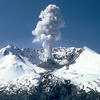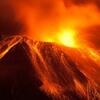In this video from TED-Ed, dig into the science of how new volcanoes form. Where do new volcanoes like this come from, and what triggers their unpredictable eruptions?
U.S. Volcanoes and Current Activity Alerts

There are 169 potentially active volcanoes in the U.S. The mission of the USGS Volcano Hazards Program is to enhance public safety and minimize social and economic disruption from volcanic unrest and eruption. USGS accomplishes this by delivering effective forecasts, warnings, and information about volcano hazards based on scientific understanding of volcanic processes.
Monitoring Volcano Activity at Yellowstone National Park
When you think of Yellowstone, you might immediately think of Old Faithful. The reliable geyser is a clear sign of how geologically active the region is! The U.S. Geological Survey’s Yellowstone Volcano Observatory (YVO) is a consortium of nine state and federal agencies who provide timely monitoring and hazard assessment of volcanic, hydrothermal, and earthquake activity in the Yellowstone Plateau region. Mike Poland, Scientist-in-Charge of the Yellowstone Volcano Observatory, provides monthly updates on activity in the region, including this video from earlier this month. You may view September’s video here.
What’s Happening at Kīlauea Volcano’s Summit?
The Kīlauea Volcano's summit has been in an eruptive pause since the 2018 events ended. Nevertheless, it remains a dynamic place. Ongoing inflation and seismicity indicate that the summit magma chamber is gradually recharging. A water lake, unprecedented in the written historical record, appeared at the bottom of Halema‘uma‘u in late July 2019 and has steadily risen. What are the potential hazards at Kīlauea’s summit? Could explosive activity return? What is known about the water lake? How is it monitored? U.S. Geological Survey Hawaiian Volcano Observatory geologists Matt Patrick and Tricia Nadeau answer these questions and more in this Volcano Awareness Month talk presented in January 2020. For a comprehensive exploration of Kīlauea Volcano eruptions, view this USGS video from 2017.
Killer Lakes
You read that correctly. What you can’t see can kill you. As this video from National Geographic explains, volcanic gases bubble to the surface, releasing high concentrations of carbon dioxide and turning lakes into silent killers. Video recommended by the Department of Earth and Environmental Science in Temple’s College of Science and Technology and used as a teaching tool in the class Disasters: Geology vs. Hollywood.

